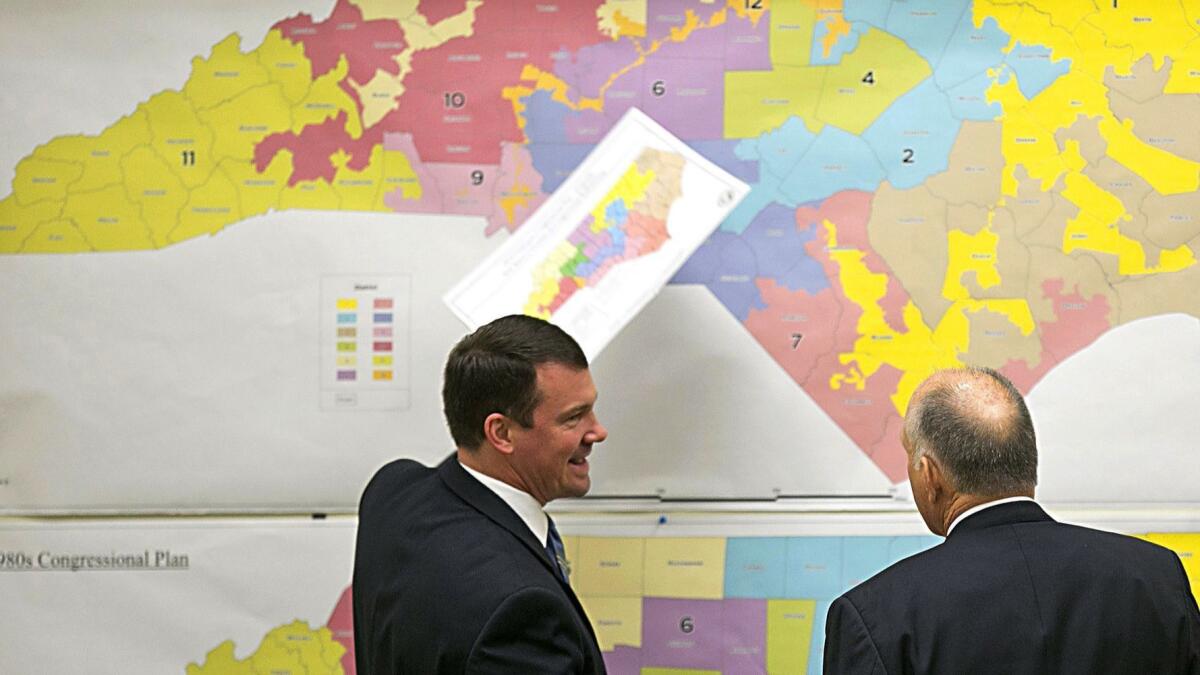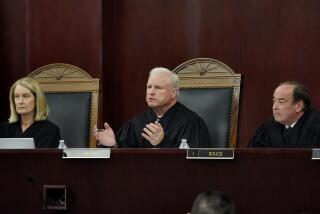Justice Kavanaugh may hold swing vote on partisan gerrymandering

Reporting from Washington — The Supreme Court justices sounded closely split Tuesday during arguments over whether to rein in partisan gerrymandering of congressional districts, with new Justice Brett M. Kavanaugh probably holding the deciding vote.
The four liberal justices, all Democratic appointees, said the court was confronting the “worst of the worst” examples of politically motivated gerrymandering in cases from North Carolina and Maryland.
It is “so dramatically wrong … to leave all this to professional politicians” who rig the outcomes, said Justice Elena Kagan.
But most of the court’s conservatives, all Republican appointees, sounded just as insistent that the Constitution left it to state lawmakers, not federal judges, to draw election districts for members of Congress.
“Why should we wade into this?” asked Justice Neil M. Gorsuch.
If there was one encouraging sign for the challengers, it was that Kavanaugh seemed open to interceding in cases of extreme gerrymandering. He repeatedly asked whether the Constitution calls for “proportional representation” in Congress, so that the political views of the elected members of Congress would roughly match the political views of the state’s voters.
None of the lawyers gave a firm answer to Kavanaugh’s question, but he suggested that the extreme deviations in the cases under consideration could be struck down.
North Carolina’s map gave Republicans a 10-3 majority, even though they won just 51% of the vote.
In the Maryland case, Democrats redrew the districts in 2011 to eliminate one Republican stronghold. The revised map gave Democrats a 7-1 majority in the state’s congressional delegation.
That may go too far, Kavanaugh, who lives in Maryland, told a state lawyer. “The 7-1 is a problem. The 5-3 is almost certainly not a problem, which I think has got to be right ... because it’s close to the proportion of Democrats and Republicans in the state,” he said at one point.
If Kavanaugh were to stick with that view, it could transform the court’s approach to partisan gerrymandering. For more than 30 years, the court has struggled with gerrymandering but has never struck down a state’s election districts on the grounds that they were so unfair as to deny one party’s voters equal representation.
In the past, Chief Justice John G. Roberts Jr. said he believed the Constitution left the election map to state legislators, He could now be in a position to close the door to partisan gerrymandering claims in the future, but only if Kavanaugh is prepared to join him.
The other justices on the right said they did not see a way to create a clear, legal test for deciding when ordinary politics goes too far and becomes unconstitutional.
“I know it when I see it,” Gorsuch said in a mocking reference to the court’s struggle to define obscenity in the 1960s.
In the North Carolina case, a three-judge federal court last year struck down the partisan gerrymandering by saying it discriminated against voters in violation of the 1st Amendment and the guarantee of equal protection of the laws.
The state’s lawyer, former U.S. Solicitor Gen. Paul Clement, urged the court to reverse that ruling and declare that the Constitution gave the power over election districts to elected legislators. The case is Rucho vs. Common Cause.
Meanwhile, a Maryland state attorney urged the justices to toss out a similar ruling that struck down its Democratic plan. That case is Lamone vs. Benisek.
In both cases, the architects of the election maps admitted they were acting for partisan motives.
Three years ago, Republican state Rep. David Lewis opened a North Carolina legislative session on redistricting by proposing to use the latest political data to benefit Republicans and “draw the maps to give a partisan advantage to 10 Republicans and three Democrats because I do not believe it’s possible to draw a map with 11 Republicans and two Democrats.”
Maryland’s Democrats were nearly as blunt in their motives when they redrew districts, deciding they would shift more than 300,000 people to convert a solidly Republican district into a reliably Democratic one. They succeeded in creating a U.S. House delegation that had seven Democrats and only one Republican.
Last year, the chief justice wrote an opinion that overturned a partisan gerrymandering ruling against Wisconsin’s Republicans. He said the Democratic voters who filed the suit did not have standing to challenge the statewide electoral map for its state Assembly. That ruling, in Gill vs. Whitford, allowed the Wisconsin GOP to maintain a supermajority control of its lower legislative house, despite winning only 44% of the votes statewide.
In decades past, Justice Anthony M. Kennedy had left the door open to ruling that partisan gerrymandering was unconstitutional because it discriminated against voters due to their political views. But he never voted to strike down an election map as unconstitutional partisan gerrymandering, and he retired last year shortly after the Roberts-led punt in the Wisconsin case.
Allison Riggs, a voting rights lawyer from North Carolina, warned the justices of “the risk of doing nothing” on redistricting as the 2020 census approaches. If the high court punts again or upholds the gerrymandered districts, it “will be read as a green light for this kind of discriminatory rhetoric and manipulation in redistricting from here on out,” she said on behalf of the League of Women Voters.
She is not likely to win over the chief justice, however.
Roberts spelled out his view four years ago when he dissented in a 5-4 ruling upholding independent commissions authorized by voters in Arizona and California to draw election districts. The chief justice pointed to a provision in the Constitution that says “the times, places and manner of holding elections” for members of Congress “shall be prescribed in each state by the legislature thereof.”
Roberts said that meant only elected lawmakers may decide on election districts. “No matter how concerned we may be about partisanship in redistricting, this court has no power to gerrymander the Constitution,” he wrote in dissent then.
More stories from David G. Savage »
More to Read
Get the L.A. Times Politics newsletter
Deeply reported insights into legislation, politics and policy from Sacramento, Washington and beyond. In your inbox three times per week.
You may occasionally receive promotional content from the Los Angeles Times.











